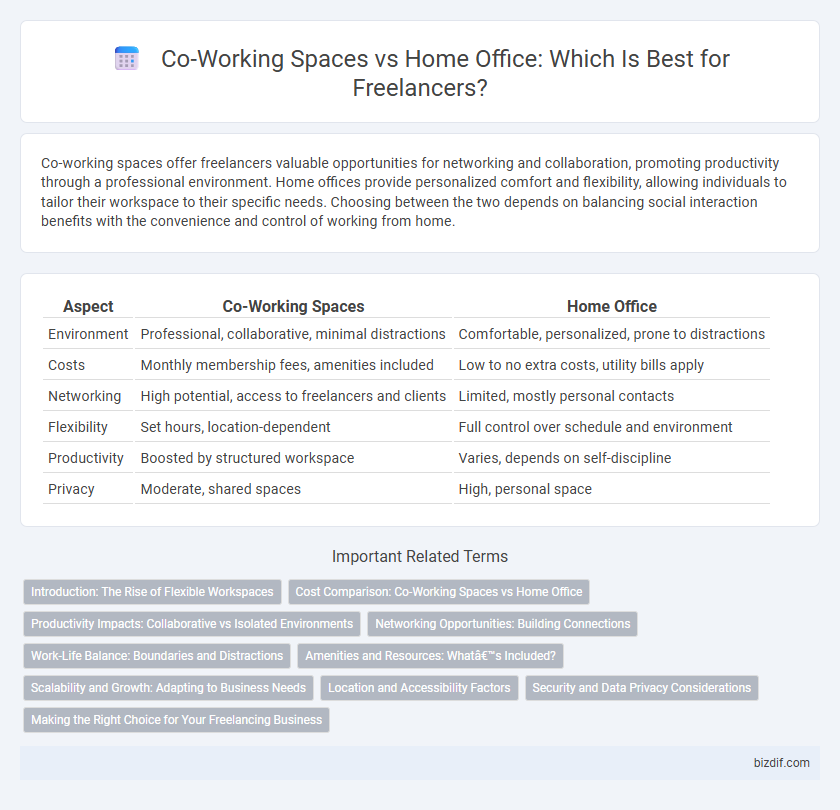Co-working spaces offer freelancers valuable opportunities for networking and collaboration, promoting productivity through a professional environment. Home offices provide personalized comfort and flexibility, allowing individuals to tailor their workspace to their specific needs. Choosing between the two depends on balancing social interaction benefits with the convenience and control of working from home.
Table of Comparison
| Aspect | Co-Working Spaces | Home Office |
|---|---|---|
| Environment | Professional, collaborative, minimal distractions | Comfortable, personalized, prone to distractions |
| Costs | Monthly membership fees, amenities included | Low to no extra costs, utility bills apply |
| Networking | High potential, access to freelancers and clients | Limited, mostly personal contacts |
| Flexibility | Set hours, location-dependent | Full control over schedule and environment |
| Productivity | Boosted by structured workspace | Varies, depends on self-discipline |
| Privacy | Moderate, shared spaces | High, personal space |
Introduction: The Rise of Flexible Workspaces
The rise of flexible workspaces has transformed freelancing by offering alternatives to traditional home offices. Co-working spaces provide freelancers with professional environments, networking opportunities, and access to amenities, enhancing productivity and collaboration. In contrast, home offices offer comfort and cost savings but may lack social interaction and external motivation.
Cost Comparison: Co-Working Spaces vs Home Office
Co-working spaces typically involve a fixed monthly fee ranging from $200 to $600, covering utilities, internet, and amenities, whereas home office costs are more variable, including initial setup expenses and ongoing utility bills that may total $100 to $300 monthly. While co-working spaces provide scalable rental options and networking opportunities, home offices offer long-term cost savings by eliminating recurring rental fees. Evaluating total expenditures depends on factors like location, frequency of use, and the need for professional environments versus comfort and convenience at home.
Productivity Impacts: Collaborative vs Isolated Environments
Co-working spaces enhance productivity by fostering collaboration, networking opportunities, and immediate feedback, which stimulate creativity and problem-solving among freelancers. In contrast, home offices provide a controlled, distraction-free environment that supports deep focus and individualized work rhythms, ideal for tasks requiring concentration. Balancing these environments depends on the freelancer's workflow needs, with co-working spaces benefiting collaborative projects and home offices favoring solitary, intensive productivity.
Networking Opportunities: Building Connections
Co-working spaces offer abundant networking opportunities by bringing together freelancers from diverse industries, fostering collaboration and idea exchange. Unlike a home office, these environments provide access to professional events, workshops, and informal meetups that can lead to valuable business connections. Utilizing co-working spaces can accelerate growth through direct interaction with potential clients, mentors, and partners.
Work-Life Balance: Boundaries and Distractions
Co-working spaces provide freelancers with clearly defined professional boundaries that help separate work from personal life, reducing distractions often found in home offices. These environments cultivate a productive atmosphere through dedicated work zones, minimizing interruptions from household responsibilities or family members. Setting distinct spatial and mental boundaries in co-working spaces enhances work-life balance by promoting focus during work hours and relaxation outside of them.
Amenities and Resources: What’s Included?
Co-working spaces offer a range of amenities including high-speed internet, meeting rooms, office equipment, and communal areas that foster collaboration, while home offices rely on personal resources which may vary widely in quality and availability. Access to professional-grade printers, ergonomic furniture, and networking events is typically included in co-working memberships, enhancing productivity and social interaction. Home office setups often require freelancers to invest individually in technology, office supplies, and maintenance, potentially increasing overall costs and limiting resource availability.
Scalability and Growth: Adapting to Business Needs
Co-working spaces offer scalable work environments with flexible membership plans that accommodate business growth and fluctuating team sizes. Home offices limit expansion potential due to space constraints and lack of professional infrastructure. Choosing co-working spaces enables freelancers to adapt quickly to evolving business needs and client demands.
Location and Accessibility Factors
Co-working spaces offer strategic locations in city centers with easy access to public transportation, boosting professional networking opportunities and convenience for freelancers. Home offices provide the comfort of no commute but may lack the accessibility and vibrant business environment that co-working spaces foster. Proximity to clients and resources in co-working locations enhances productivity, while home offices require effective self-management to compensate for potential isolation.
Security and Data Privacy Considerations
Co-working spaces often expose freelancers to higher risks of data breaches due to shared networks and public access, making secure VPNs and encrypted communication essential. Home offices provide greater control over physical and digital security, allowing freelancers to implement customized firewalls and access restrictions suited to sensitive client information. Prioritizing robust cybersecurity measures, regardless of the workspace, is critical to safeguarding confidential data and maintaining client trust in freelancing projects.
Making the Right Choice for Your Freelancing Business
Choosing the right workspace significantly impacts productivity and work-life balance in freelancing. Co-working spaces offer networking opportunities, structured environments, and fewer distractions, while home offices provide convenience, personalized comfort, and cost savings. Assessing your project needs, communication habits, and focus requirements helps in making an informed decision that aligns with your freelancing business goals.
Co-Working Spaces vs Home Office Infographic

 bizdif.com
bizdif.com